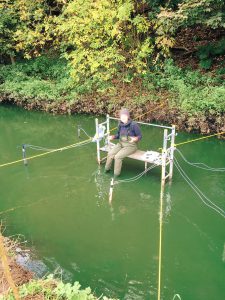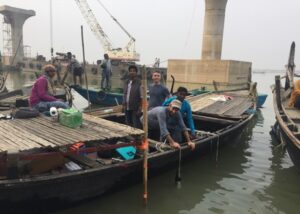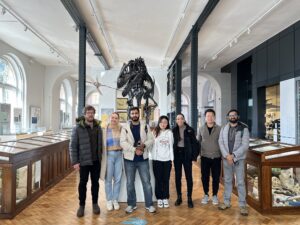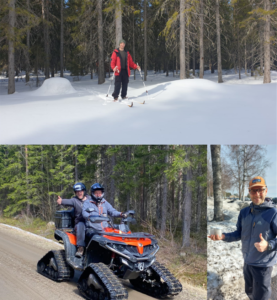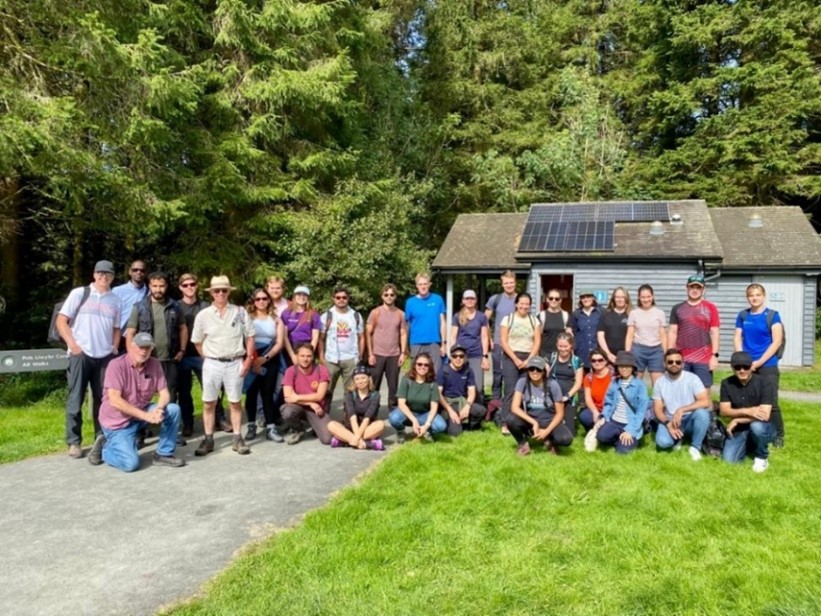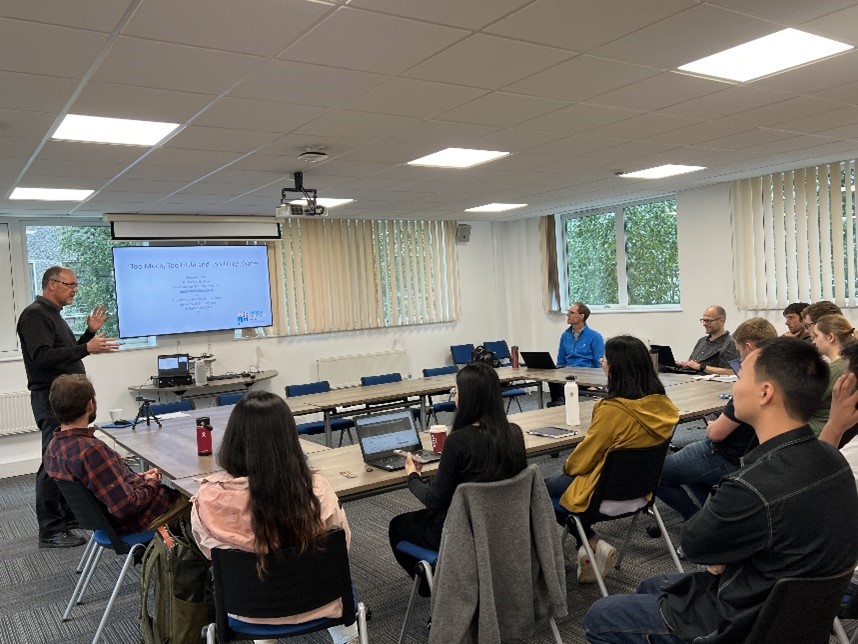Group Leader - Prof Stefan Krause
Focused on the fate and transport of contaminants (microplastics and chemicals) in the environment. Specifically looking at the interface between surface water and ground water. We have a strong interdisciplinary team composed of research students and staff that are researching innovative and cutting edge methods.
Summary
Our research combines the development of new field-based and lab-analytical technologies for tracing environmental pollution and climate change stressors in freshwater ecosystems with integrated modelling approaches to predict ecosystem responses to interacting environmental stressors under changing environmental conditions and management practices.
Impact
The technological solutions and mechanistic process understanding derived by our research supports our partners in the private and public sectors to assess the impacts of legacy and emerging pollutants and stressors and develop adequate river basin management practices for wicked water problems in intensively used landscapes under change.
Our research on the fate and transport of contaminants at ecohydrological interfaces between surface water and groundwater spans across a wide range of spatial and temporal scales. This allows us to investigate non-linear ecohydrological process dynamics and responses to environmental change, including the analysis of hotspots and hot moments, tipping points and threshold in ecohydrological and biogeochemical functioning. Our strongly interdisciplinary research investigates the impacts of global environmental change on hydrological fluxes, biogeochemical cycling and ecohydrological feedback functions in complex landscapes. The internationally recognised research of the group particularly focuses on the analysis and quantification of multi-component reactive transport processes across heterogeneous aquifer-river interfaces, combining the interactions between emerging pollutants (pharmaceuticals, microplastics, engineered nanoparticles) and legacy pollutants (nitrate, chlorinated solvents) and how these are influenced by changes in land-use and climate.
Our research combines the development of innovative field and laboratory experimental technologies with novel modelling techniques for investigating the interlinked cycling of nutrients and reactive transport of emerging contaminants as well as legacy pollutants. Our group is spear-heading the development of real-time geophysical and hydro-chemical monitoring approaches (HiFreq H2020-RISE–ITN-2016) and novel distributed sensor network technology (NERC NE/L012715/1) together with reactive “smart tracers” (NERC-NE/I016120/1) and adaptive modelling strategies for investigating the efficiency of interconnected nitrogen and carbon cycling in reactive “hotspots” and “hot moments” at aquifer-river interfaces in dependency of microbial metabolic activity and organic matter decomposition rates (NERC NE/M005151/1). This work includes the pioneering of interdisciplinary frameworks for the holistic analysis of geophysical controls on biogeochemical and ecohydrological hotspots in hyporheic zones (Leverhulme International Hyporheic Zone Network; HypoTRAIN H2020-MSCA-ITN-2014) and across different ecohydrological interfaces (INTERFACES FP7-PEOPLE-2013-ITN). Together with private and public sectors practitioners in the UK, EU and world-wide, we are developing on practical solutions to enhance these functions in river restoration practice (NERC NE/L003872/1) and to assess the impact of aquatic ecosystem metabolic activity on the global Nitrogen and Carbon cycles and the production of greenhouse gases (MarshFLUX H2020-2019-IF; JABBS-FutureForests). Integrating my hydro-geophysical and environmental chemistry research, recent activities have been focussing specifically into exploring the hydrodynamic controls on reactive transport of emerging contaminants such as pharmaceuticals, engineered nanoparticles and microplastics at aquifer-river interfaces (NERC NE/T004533/1NanoTOX, MicroPATH, IDEX-AquaPlast, Leverhulme PlasticRivers), revealing the real magnitude of microplastic accumulation in river corridors to exceed plastic waste found in the world’s oceans.
Current research projects, please use the hyperlinks where provided for further information.
– SmartWater – Diagnosing controls of pollution hot spots and hot moments and their impact on catchment water quality
– MedTestPlastic – Developing a Circular Economy for Medical Testing Plastics.
– QS-GAMES – Quantum Sensing – Ground, and Aquifer Monitoring for Environmental Sciences
Started 2022
– PlasticUnderground – Integrated Cross-Sectoral Solutions to Micro- and Nanoplastic Pollution in Soil and Groundwater Ecosystems
-Fate, transport and risks of microplastics in the subsurface
– MulchPlastRisk – Identifying the risks of micro- and nanoplastics (MnP) from agricultural mulching to groundwater
– Game-Changer A-DTS – Active-Distributed Temperature Sensing of underground heat and water fluxes
– PlaStyx – Microplastics in groundwater ecosystems: a global impact analysis
– Microplastic Fate and Transport in Large Managed River and Aquifer Systems
–MICROPATH – The fate and persistence of microplastics and associated pathogens in lowland rivers
–Future Forests – Irrigation and fertilisation impacts on greenhouse gas emission from Oak forests
– Biodegradable Bioplastics. – Study of array of bioplastics and degradability
– IDEX – Environmental Plastics – Fate, transport and environmental impacts of microplastics in aquatic ecosystems
–NanoTOX – does climate change enhance the nano particle toxicity of freshwater biofilms?
– Greenhouse gas emissions from temperature zone costal wetlands
– Impacts of root exudates on mangrove greenhouse gas emissions
– Plastic Rivers – The fate and transport of microplastics in rivers
– Water challenges in a changing world
– Fate and transport of microplastics in soils and freshwater ecosystems
– Large scale landscape controls on microplastic fate and transport
– GW-Storm – Reducing storm-induced contamination risks to water supply infrastructure by Active Fibre-optic Distributed Temperature Sensing
– FAR-GANGA – Future Secular Changes & Remediation of Groundwater Arsenic in the Ganga Basin
–INTERACT, Tracer-based quantification of hyporheic exchange rates in a Boreal stream
– The Forest Edge – Emergent Properties and Contested Spaces – Leverhulme Trust Doctoral Scholarships Programme
–HiFreq – Smart high-frequency environmental sensor networks for quantifying non-linear hydrological process dynamics across spatial scales
– HypoTRAIN – A training network for enhancing the understanding of physical chemical and biological process interactions
– Large Woody Debris – A river restoration panacea for streambed nitrate attenuation?
– INTERFACES – Ecohydrological interfaces as critical hotspots for transformations of ecosystem exchange fluxes and biogeochemical cycling
Please use the following hyperlinks to visit the research profiles of existing group members.
Postdoctoral Researchers
- Dr Zoraida Quionones (PlasticUnderground)
- Dr Liam Kelleher (Institute of Global Innovation) “Water Challenges in a Changing World”
- Dr Uwe Schneidewind (DFG – German Research Foundation) “Fate and Transport of Microplastics in Freshwater Sediments”
- Dr Reza Dehbandi (EU MSCA Horizon Europe Marie Curie Individual Fellowship)
- Dr Jing Liu (CSC – Chinese Science Council) “Nutrient transport at Aquifer-River Interfaces”
PhD Research Students and Projects
- Kexin Li (01/2023 – ) “Greenhouse gas emissions from contaminant fate and transport at aquifer-river interfaces” (co-supervisor: S. Comer-Warner)
- Yuxia Yang (10/2022 – ) “Microplastic fate and transport in groundwater” SUSTECH-UoB joint PhD Programme (co-supervisor: S. Comer-Warner, Y. Zhang)
- Linh, Duong Anh (12/2022 – ) “Impacts of irrigation management on microplastic pollution in Red River Delta soils” Vietnam National University (co-supervisor: I. Lynch, S. Comer-Warner)
- Mohammad Alharbi (05/2022 – ) “Interactions between surface and groundwater flooding” (co-supervisor S. Han)
- Nick Lugg (2022 – ) “Water quality sensor network innovations for source area attribution during storm events” NERC CENTA, main supervisor (co-supervisors: Joshua Larsen, David M. Hannah, Glenn Watts)
- Rhys Gardner (10/2022 – ) “Biodegradable Plastics” Unilever (co-supervisor: A. Dove)
- Fatima Khan (10/2021) “Water isotopes to understand tree water use efficiency under elevated CO2)” NERC CENTA (co-supervisors: J. Larsen)
- Katharine Rowley (10/2021 – ) “Environmental Fate and Transport of Car Tyre and Brake Wear and Tear Plastic Particles” NERC CENTA + Arup Case (co-supervisors: I. Lynch, G. Sambrook-Smith)
- Louisa Brenninkmeijer (10/2021 – ) “Environmental fate and transport of biodegradable polymer formulations” Unilever (co-supervisor: A. Dove)
- Nans Barthelemey (06/2021 – ) “Fate and transport of plastics in intermittent streams” (co-supervisors: Thibault Datry, Laurent Simon)
- Camille Touchet (2021 – ) “Fate and transport of microplastics in freshwater ecosystem interfaces” (co-supervisor F. Mermillod-Blodin, L. Simon)
- Grace Davies (09/2020 – ) “The environmental fate of biodegradable bioplastics from fertilizer encapsulations in agricultural soils” Syngenta Ltd., main-supervisor (co-supervisor I. Lynch)
- Dominic Eardly (09/2020 – ) “Stream temperature dynamics in Scottish river networks under climate change” Royal Society, co-supervisor (main supervisor D.M.Hannah)
- Andrea Rabbai (01/2020 – ) “Forest management impacts on soil moisture dynamics and greenhouse gas emissions” JABBS Foundation, main supervisor (co-supervisors Sami Ullah, Nick Kettridge)
- Hongzheng Hong (2020 – ) “High-frequency tracing of urban water quality extremes during storm events” self-funded, main supervisor (co-supervisor D.M. Hannah)
- Gianni Micucci (09/2019 – ) “New approaches for in-situ sensing of nitrogen processing in agricultural soils” Leverhulme Trust – The Forest Edge, co-supervisor (main supervisor: Sami Ullah)
- Eleanor Pike (09/2018 – ) “Quantum sensors for monitoring sub-surface soil water dynamics” EPSRC – Quantum Technology Hub, main supervisor (co-supervisors: David Hannah, Kai Bongs, Jeff McDonnell)
- Susan Quick (09/2016 – ) “Water restrictions to increases in forest primary production due to enhanced atmospheric CO2” co-supervisor, BIFoR (main supervisor: R. MacKenzie)
Former Researchers/Alumni of the Group
- Sophie Comer-Warner – now Ass. Prof at University of Birmingham (Bridge Fellow)
- Dr Andre-Marie Dendievel (IDEX-Lyon) – now Ass. Prof. “Large scale landscape controls on microplastic fate and transport”
- Dr Jennifer Drummond (EU MSCA Horizon Europe Marie Curie Individual Fellowship, Royal Society International Newton Fellowship)
- Dr Marie Arnaud – now research scientist at INRAE
- Dr Berta Bonnett – now research scientist at University of Girona
- Dr Valery Ouellet – now staff scientist at NOAA
- Dr Holly Nel – now senior scientist at CEFAS
- Dr Yasmin Yonan – now data analyst
- Dr Feng Mao – now Lecturer at Cardiff University
- Dr Karlie McDonald – now Senior Scientist at CSIRO
- Dr Phillip Blaen – now R&D lead at Yorkshire Water
- Dr Megan Klaar – now Lecturer at University of Leeds
- Dr Davide Dapello – now Lecturer at Bolton University
- Dr Giulio Curioni – now Head of data management at BIFoR – Birmingham Institute of Forest Research
- Dr Steve Allen – now Lecturer at University of Strathclyde
- Dr Francesco Ciocca – now at Agilent Ltd.
Completed PhD Students
- Mohammad Wazne (01/2020 – 2023) “Microplastic uptake and sycling at streambed-water interfaces” IDEX Lyon, main supervisor (co-supervisors: Laurent Simon, Florian Mermillod-Blondin, University Lyon1)
- Anna Kukkola (09/2018 – 2023) “Fate and transport of microplastics in freshwater ecosystems” Leverhulme Trust – Freshwater Plastics, main supervisor (co-supervisors: Iseult Lynch, Greg Sambrook Smith)
- Ben Howard (09/2018 – 2023) “Enhancing streambed metabolism and nitrogen turnover by dead wood management in river restoration practice” Leverhulme Trust – Forest Edge, main supervisor (co-supervisors: Sami Ullah, Nick Kettridge)
- Anna Jaeger (04/2015 – 2023) “High-frequency dynamics of emergent pollutant cycling in hyporheic zones of urban streams” EU H2020 HypoTrain ITN, co-supervisor (main supervisor: J. Lewandowski)
- Nicolai Brekenfeld (09/2016 – 01/2021) “Event-based dynamics of streambed metabolism” NERC CENTA studentship with CASE support from HydroResearch Ltd. co- supervisors: Kevin Bishop, Hjalmar Laudon (SLU), Nick Kettridge, David Hannah (UoB)
- Liwen Wu (05/2015 – 04/2020) “Modelling of transient, event-based dynamics of hyporheic exchange flow” EU H2020 HypoTrain ITN, co-supervisor (main supervisor: J. Lewandowski)
- Tanu Singh (09/2015 – 01/2020), “Model-based Identification of Drivers of Hyporheic Zone Biogeochemical Reactivity Hotspots”. EU H2020 HypoTrain ITN, main supervisor (co-supervisor: D.M. Hannah)
- Jon MacKay (09/2015 – 02/2020), “Assessment of Climate Change Impact on Coupled Ice and Water Resource Dynamics in Glaciated Catchments” NERC CENTA Case funded, co-supervisor (main supervisor N. Barrand)
- Alexander Hurley (09/2015 – 02/2020), “Impacts of Ephemeral Droughts on Ecohydrological Process Dynamics in the Canadian Arctic” Industry funded, co-supervisor (main supervisor N. Kettridge)
- Roswen Leonard (09/2013 – 09/2019) “The ecohydrological functioning of the Canadian Western Boreal Plain and its response to wildfire” NERC funded. co-supervisor (main supervisor: N. Kettridge)
- Paul Romeijn (04/2014 – 04/2018), “Hyporheic Controls on Whole Stream Metabolism and Greenhouse Gas Production” EU-FP7 INTERFACES ITN, main supervisor (co-supervisor: D.M. Hannah)
- Sophie Comer (09/2014 – 03/2018), “Novel Passive Sampling and Isotopic Tools for Quantifying Hyporheic and Riparian Biogeochemical Turnover and Greenhouse Gas Production” NERC CENTA Case funded, main supervisor (co-supervisor: D. Gooddy, BGS)
- Silvia Folegot (12/2013 – 03/2018), “Distributed Sensor Networks for Quantifying Drought Impacts on River and Streambed Thermal Extremes” EIT – Climate KIC, main supervisor (co-supervisors: D.M. Hannah, W. Buytaert, Imperial College)
- Amaia Maruedo (05/2014 – 01/2018) “Scaling of heat tracer methods for quantification of ecohydrologial interface fluxes” EU-FP7 INTERFACES ITN, co-supervisor (main-supervisor: J. Lewandowski, IGB Berlin)
- Rebwar Nasir (04/2013 – 08/2017) “Geophysical Exploration of Subsurface Controls of Groundwater-Surface Water Exchange Flow Patterns” Scholarship of the Kurdish-Iraqi Government, main supervisor (co-supervisor: M. Rivett)
- Victor Baranov (2014 – 2017)“The impact of bioturbating invertebrates on hyporheic and bentic biogeochemical cycling and greenhouse gas production” EU-FP7 INTERFACES ITN, co-supervisor (main-supervisor: J. Lewandowski, IGB Berlin)
- Safieh Javadinejad (2012 – 2016) “Improved river basin management and adaption strategies through better understanding of climate change impacts”, co-supervisor (main supervisor: D.M. Hannah)
- Abdul Al-Juhani (2012 – 2016)“Water Resource Management in an Arid Wadi System” self funded, co-supervisor (main supervisor: J. Tellam)
- John Weatherill (2010 – 2014) “Novel approaches for tracing multi-component reactive transport and contaminant transformation patterns at aquifer-river interfaces“, Environment Agency & EPSAM, co-supervisors: Kevin Voyce (Environment Agency), Nigel Cassidy (Keele University), Sami Ullah (Keele University)
- Amir Levy (2010 – 2014) “The effect of glacier fluctuation on shallow hydrogeological systems of glaciers in South East Iceland“, EPSAM, co-supervisors: Z. Robinson, R. Waller (Keele University)
For the latest publication details please see Stefan’s ORCID account.
Recent Publications
Article
Abesser, C, Ciocca, F, Findlay, J, Hannah, D, Blaen, P, Chalari, A, Mondanos, M & Krause, S 2020, ‘A distributed heat pulse sensor network for thermo-hydraulic monitoring of the soil subsurface‘, Quarterly Journal of Engineering Geology and Hydrogeology, vol. 53, no. 3, pp. 352-365. https://doi.org/
Hannah, DM, Lynch, I, Mao, F, Miller, JD, Young, SL & Krause, S 2020, ‘Author Correction: Water and sanitation for all in a pandemic‘, Nature Sustainability. https://doi.org/
Posselt, M, Mechelke, J, Rutere, C, Coll, C, Jaeger, A, Raza, M, Meinikmann, K, Krause, S & Sobek, A 2020, ‘Bacterial diversity control transformation of wastewater-derived organic contaminants in river-simulated flumes‘, Environmental Science and Technology. https://doi.org/
Nel, HA, Smith, GHS, Harmer, R, Sykes, R, Schneidewind, U, Lynch, I & Krause, S 2020, ‘Citizen science reveals microplastic hotspots within tidal estuaries and the remote Scilly Islands, United Kingdom‘, Marine Pollution Bulletin, vol. 161, 111776. https://doi.org/
Singh, T, Gomez-Velez, JD, Wu, L, Wörman, A, Hannah, DM & Krause, S 2020, ‘Effects of Successive Peak Flow Events on Hyporheic Exchange and Residence Times‘, Water Resources Research, vol. 56, no. 8, e2020WR027113. https://doi.org/
Wu, L, Gomez-Velez, JD, Krause, S, Singh, T, Worman, A & Lewandowski, J 2020, ‘Impact of flow alteration and temperature variability on hyporheic exhange‘, Water Resources Research, vol. 56, no. 3, e2019WR026225. https://doi.org/
Klaar, MJ, Shelley, FS, Hannah, DM & Krause, S 2020, ‘Instream wood increases riverbed temperature variability in a lowland sandy stream‘, River Research and Applications, vol. 36, no. 8, pp. 1529-1542. https://doi.org/
Mackay, JD, Barrand, NE, Hannah, DM, Krause, S, Jackson, CR, Everest, J, MacDonald, AM & Dochartaigh, BÉÓ 2020, ‘Proglacial groundwater storage dynamics under climate change and glacier retreat‘, Hydrological Processes, vol. 34, no. 26, pp. 5456-5473. https://doi.org/
Comer-Warner, SA, Gooddy, DC, Ullah, S, Glover, L, Kettridge, N, Wexler, SK, Kaiser, J & Krause, S 2020, ‘Seasonal variability of sediment controls of nitrogen cycling in an agricultural stream‘, Biogeochemistry, vol. 148, no. 1, pp. 31-48. https://doi.org/
Hannah, DM, Lynch, I, Mao, F, Miller, JD, Young, SL & Krause, S 2020, ‘Water and sanitation for all in a pandemic‘, Nature Sustainability. https://doi.org/
Comment/debate
Javadinejad, S, Hannah, D, Krause, S, Dara, R, Jafary, F & Naseri, M 2020, ‘The impacts of climate change on energy-water systems and economic analysis‘, Iraqi Geological Journal, vol. 53, no. 2F, pp. 1-17.
Review article
Krause, S, Baranov, V, Nel, HA, Drummond, JD, Kukkola, A, Hoellein, T, Sambrook Smith, GH, Lewandowski, J, Bonnet, B, Packman, AI, Sadler, J, Inshyna, V, Allen, S, Allen, D, Simon, L, Mermillod-Blondin, F & Lynch, I 2021, ‘Gathering at the top? Environmental controls of microplastic uptake and biomagnification in freshwater food webs‘, Environmental Pollution, vol. 268, no. Pt A, 115750. https://doi.org/
Mao, F, Khamis, K, Clark, J, Krause, S, Buytaert, W, Ochoa-Tocachi, BF & Hannah, DM 2020, ‘Moving beyond the Technology: A Socio-technical Roadmap for Low-Cost Water Sensor Network Applications‘, Environmental Science and Technology, vol. 54, no. 15, pp. 9145-9158. https://doi.org/
Ouellet, V, St-Hilaire, A, Dugdale, SJ, Hannah, DM, Krause, S & Proulx-Ouellet, S 2020, ‘River temperature research and practice: Recent challenges and emerging opportunities for managing thermal habitat conditions in stream ecosystems‘, Science of the Total Environment, vol. 736, 139679, pp. 139679. https://doi.org/
Comer-Warner, S, Knapp, JLA, Blaen, P, Klaar, M, Shelley, F, Zarnetske, J, Lee-Cullin, J, Folegot, S, Kurz, M, Lewandowski, J, Harvey, J, Ward, A, Mendoza-Lera, C, Ullah, S, Datry, T, Kettridge, N, Gooddy, D, Drummond, J, Martí, E, Milner, A, Hannah, D & Krause, S 2020, ‘The method controls the story – Sampling method impacts on the detection of pore-water nitrogen concentrations in streambeds‘, Science of the Total Environment, vol. 709, 136075. https://doi.org/
Latest News
Prof Grafton Presentation – Water Seminar Series 2023
New PGR Student
Media


